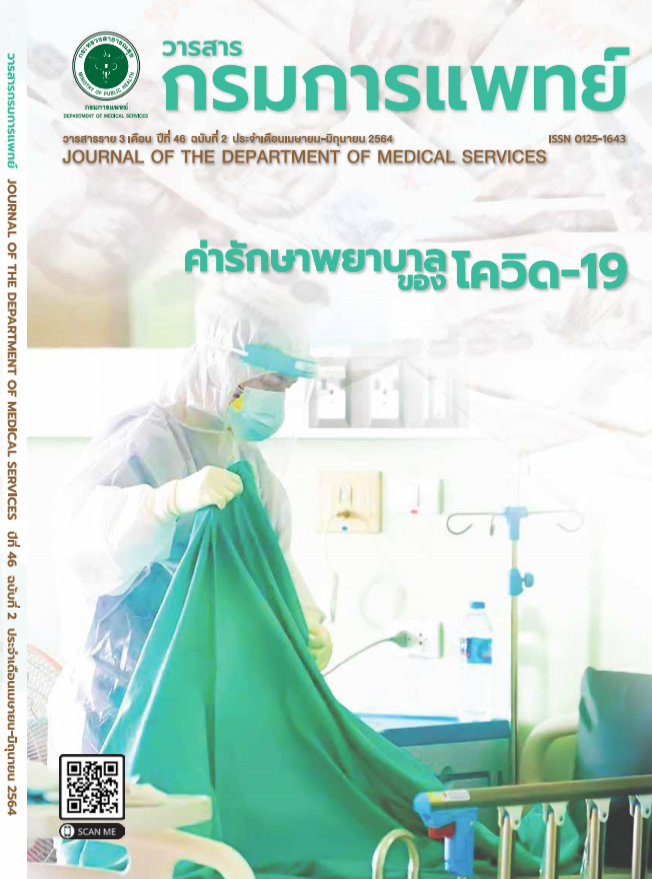ค่าความถูกต้องของการใช้เครื่องสแกนในช่องปากเปรียบเทียบกับการจำลองช่องปากด้วยการพิมพ์ปากด้วยวัสดุพิมพ์ปาก ทางคลินิก: การทบทวนอย่างเป็นระบบและการวิเคราะห์อภิมาน
คำสำคัญ:
ความถูกต้อง, เครื่องสแกนในช่องปาก, การพิมพ์ปากด้วยวัสดุพิมพ์ปาก, การทบทวนอย่างเป็นระบบ, การวิเคราะห์อภิมานบทคัดย่อ
ภูมิหลัง: ความถูกต้องของการจำลองช่องปากมีความสำคัญ ในงานทันตกรรม การเก็บข้อมูลจากการใช้เครื่องสแกนในช่องปาก แตกต่างกับการสแกนนอกช่องปาก จึงมีความพยายามรวบรวมค่า ความถูกต้องของการใช้เครื่องสแกนในช่องปากเปรียบเทียบกับการ พิมพ์ปากที่เป็นวิธีมาตรฐาน ทั้งการสแกนระยะสั้นและการสแกน อวัยวะในช่องปากที่มีขนาดใหญ่วัตถุประสงค์: เพื่อรวบรวมข้อมูล งานวิจัยทางคลินิก ในเรื่องค่าความถูกต้องของการจำลองช่องปาก โดยใช้เครื่องสแกนในช่องปากเปรียบเทียบกับการพิมพ์ปาก และ ประเมินแนวทางตัดสินค่าความถูกต้องที่ยอมรับทางคลินิก (clinical acceptance) ของการใช้เครื่องสแกนในช่องปากวิธีการ: สืบค้น งานวิจัยที่เกี่ยวข้องจากฐานข้อมูล PubMed อย่างเป็นระบบ และ สืบค้นจากฐานข้อมูล open access และ Google scholar ร่วม กับการค้นหาด้วยมือ นำมาเฉพาะบทความภาษาอังกฤษตั้งแต่ ปี ค.ศ. 2010 ถึง ปี ค.ศ. 2021 บทความที่ได้รับการยอมรับมี 18 บทความ และนำมาทำการวิเคราะห์อภิมานโดยใช้ค่าความถูกต้อง (accuracy) ที่ได้จากการใช้เครื่องสแกนในช่องปากและจากการ พิมพ์ปาก แล้ววิเคราะห์แบ่งกลุ่มย่อย (subgroup analysis) เป็นการสแกนในระยะสั้น และการสแกนในระยะยาวหรือวัตถุที่มี ขนาดใหญ่ผล: ค่าความถูกต้องของการสแกนระยะสั้นดีกว่าการ พิมพ์ปาก แต่ไม่มีนัยสำคัญทางสถิติ (SMD = -0.255; 95% CI = -0.553, 0.042; p = 0.093) ผลของข้อมูลขาดความเป็นเนื้อเดียวกัน ปานกลาง (I2 = 56.4%) ส่วนการสแกนวัตถุขนาดใหญ่ มีค่าความ ถูกต้องด้อยกว่าการพิมพ์ปาก (SMD = 1.808; 95% CI = 0.304, 3.311; p = 0.018) ผลของข้อมูลขาดความเป็นเนื้อเดียวกันสูง (I2 = 96.8%)สรุป: เครื่องสแกนในช่องปากมีความน่าเชื่อถือในการใช้งาน ทางทันตกรรม โดยเฉพาะในการสแกนระยะสั้น แม้ว่าเครื่องสแกน ในช่องปากส่วนใหญ่มีความถูกต้องพอจะเทียบเคียงการพิมพ์ปาก แต่ยังมีความเสี่ยงต่อความไม่ถูกต้องได้มากกว่าเนื่องจากหลักฐาน ที่มีอยู่ในปัจจุบันยังมีข้อจำกัดและมีจำนวนน้อย จึงมีความจำเป็น ที่ควรมีการวิจัยที่มีคุณภาพสูงต่อไป
References
Abduo J, Elseyoufi M. Accuracy of Intraoral Scanners: A Systematic Review of Influencing Factors. Eur J Prosthodont Restor Dent 2018; 26: 101-21.
Aswani K, Wankhade S, Khalikar A, Deogade S. Accuracy of an intraoral digital impression: A review. J Indian Prosthodont Soc 2020; 20: 27-37.
Nedelcu R. In Vivo Accuracy and Precision in Prosthodontics.Digital Comprehensive Summaries of Uppsala Dissertations from the Faculty of Medicine 1625. 51 pp. Uppsala: Acta Universitatis Upsaliensis. ISBN 978-91-513-0840-1.
Michelinakis G, Apostolakis D, Kamposiora P, Papavasiliou G, Özcan M. The direct digital workflow in fixed implant prosthodontics: a narrative review. BMC Oral Health 2021;21:37.doi: 10.1186/s12903-021-01398-2.
Tabesh M, Nejatidanesh F, Savabi G, Davoudi A, Savabi O,Mirmohammadi H. Marginal adaptation of zirconia completecoverage fixed dental restorations made from digital scans or conventional impressions: A systematic review and metaanalysis.J Prosthet Dent 2021;125:603-610.
Giachetti L, Sarti C, Cinelli F, Russo DS. Accuracy of Digital Impressions in Fixed Prosthodontics: A Systematic Review of Clinical Studies. Int J Prosthodont 2020; 33:192-201.
Naidu D, Freer TJ. Validity, reliability, and reproducibility of the iOC intraoral scanner: a comparison of tooth widths and Bolton ratios. Am J Orthod Dentofacial Orthop 2013; 144: 304-10.
Hasanzade M, Shirani M, Afrashtehfar KI, Naseri P, Alikhasi M. In Vivo and In Vitro Comparison of Internal and Marginal Fit of Digital and Conventional Impressions for Full-Coverage Fixed Restorations: A Systematic Review and Meta-analysis. J Evid Based Dent Pract 2019; 19: 236-54.
McGuinness LA, Higgins JPT. Risk-of-bias VISualization (robvis):An R package and Shiny web app for visualizing risk-of-bias assessments. Res Synth Methods 2020;12: 55-61.
Wiranto MG, Engelbrecht WP, Tutein Nolthenius HE, van der Meer WJ, Ren Y. Validity, reliability, and reproducibility of linear measurements on digital models obtained from intraoral and cone-beam computed tomography scans of alginate impressions. Am J Orthod Dentofacial Orthop 2013; 143:140-7.
Atieh MA, Ritter AV, Ko CC, Duqum I. Accuracy evaluation of intraoral optical impressions: A clinical study using a reference appliance. J Prosthet Dent 2017; 118: 400-5.
Kuhr F, Schmidt A, Rehmann P, Wöstmann B. A new method for assessing the accuracy of full arch impressions in patients.J Dent 2016; 55: 68-74.
Alsharbaty MHM, Alikhasi M, Zarrati S, Shamshiri AR. A Clinical Comparative Study of 3-Dimensional Accuracy between Digital and Conventional Implant Impression Techniques. J Prosthodont. 2019; 28(4): e902-8.
Sim JY, Jang Y, Kim WC, Kim HY, Lee DH, Kim JH. Comparing the accuracy (trueness and precision) of models of fixed dental prostheses fabricated by digital and conventional workflows. J Prosthodont Res 2019; 63: 25-30.
Schmidt A, Klussmann L, Wöstmann B, Schlenz MA. Accuracy of Digital and Conventional Full-Arch Impressions in Patients:An Update. J Clin Med 2020; 9: 688. doi: 10.3390/jcm9030688.
Chochlidakis K, Papaspyridakos P, Tsigarida A, Romeo D, Chen YW, Natto Z, et al. Digital Versus Conventional Full-Arch Implant Impressions: A Prospective Study on 16 Edentulous Maxillae. J Prosthodont 2020; 29: 281-6.
Pradíes G, Zarauz C, Valverde A, Ferreiroa A, Martínez-Rus F. Clinical evaluation comparing the fit of all-ceramic crowns obtained from silicone and digital intraoral impressions based on wavefront sampling technology. J Dent 2015; 43: 201-8.
Ahrberg D, Lauer HC, Ahrberg M, Weigl P. Evaluation of fit and efficiency of CAD/CAM fabricated all-ceramic restorations based on direct and indirect digitalization: a double-blinded,randomized clinical trial. Clin Oral Investig 2016; 20: 291-300.
Chochlidakis KM, Papaspyridakos P, Geminiani A, Chen CJ,Feng IJ, Ercoli C. Digital versus conventional impressions for fixed prosthodontics: A systematic review and meta-analysis. J Prosthet Dent 2016; 116: 184-90.e12.
Zeltner M, Sailer I, Mühlemann S, Özcan M, Hämmerle CH,Benic GI. Randomized controlled within-subject evaluation of digital and conventional workflows for the fabrication of lithium disilicate single crowns. Part III:marginal and internal fit. J Prosthet Dent 2017; 117: 354-62.
Zarauz C, Valverde A, Martinez-Rus F, Hassan B, Pradies G. Clinical evaluation comparing the fit of all-ceramic crowns obtained from silicone and digital intraoral impressions. Clin Oral Investig 2016; 20: 799-806.
Rödiger M, Heinitz A, Bürgers R, Rinke S. Fitting accuracy of zirconia single crowns produced via digital and conventional impressions-a clinical comparative study. Clin Oral Investig 2017;21: 579-87.
Sakornwimon N, Leevailoj C. Clinical marginal fit of zirconia crowns and patients’ preferences for impression techniques using intraoral digital scanner versus polyvinyl siloxane material.J Prosthet Dent 2017; 118: 386-91.
Yun MJ, Jeon YC, Jeong CM, Huh JB. Comparison of the fit of cast gold crowns fabricated from the digital and the conventional impression techniques. J Adv Prosthodont 2017; 9: 1-13.
Haddadi Y, Bahrami G, Isidor F. Accuracy of crowns based on digital intraoral scanning compared to conventional impression-a split-mouth randomised clinical study. Clin Oral Investig 2019;23: 4043-50.
Park JS, Lim YJ, Kim B, Kim MJ, Kwon HB. Clinical Evaluation of Time Efficiency and Fit Accuracy of Lithium Disilicate Single Crowns between Conventional and Digital Impression. Materials (Basel) 2020; 13: 5467. doi: 10.3390/ma13235467.
The SURE Collaboration. SURE Guides for Preparing and Using Evidence-Based Policy Briefs. Version 2.1 [updated November 2011], 2011. Available from www.evipnet.org/sure
Downloads
เผยแพร่แล้ว
How to Cite
ฉบับ
บท
License

This work is licensed under a Creative Commons Attribution-NonCommercial-NoDerivatives 4.0 International License.
บทความที่ได้รับการตีพิมพ์เป็นลิขสิทธิ์ของกรมการแพทย์ กระทรวงสาธารณสุข
ข้อความและข้อคิดเห็นต่างๆ เป็นของผู้เขียนบทความ ไม่ใช่ความเห็นของกองบรรณาธิการหรือของวารสารกรมการแพทย์


